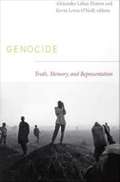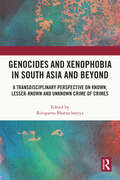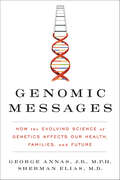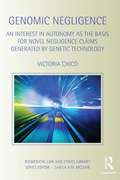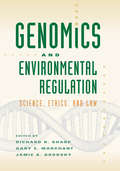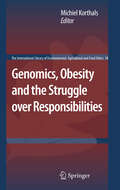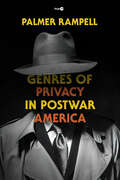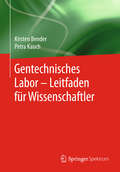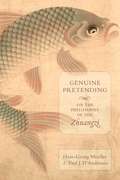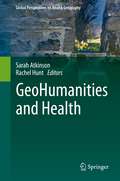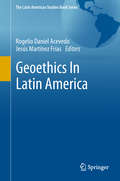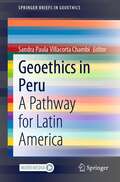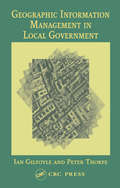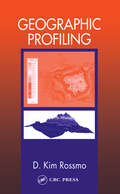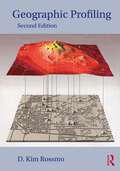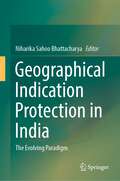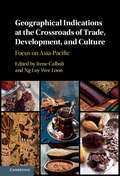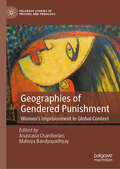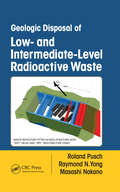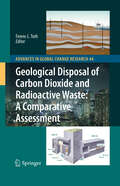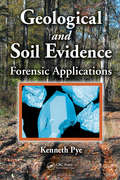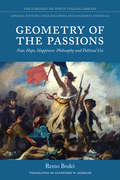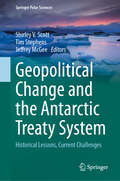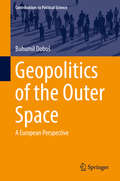- Table View
- List View
Genocide: Truth, Memory, and Representation
by Kevin Lewis O'Neill Alexander Laban HintonWhat happens to people and the societies in which they live after genocide? How are the devastating events remembered on the individual and collective levels, and how do these memories intersect and diverge as the rulers of postgenocidal states attempt to produce a monolithic "truth" about the past? In this important volume, leading anthropologists consider such questions about the relationship of genocide, truth, memory, and representation in the Balkans, East Timor, Germany, Guatemala, Indonesia, Nigeria, Rwanda, Sudan, and other locales. Specialists on the societies about which they write, these anthropologists draw on ethnographic research to provide on-the-ground analyses of communities in the wake of mass brutality. They investigate how mass violence is described or remembered, and how those representations are altered by the attempts of others, from NGOs to governments, to assert "the truth" about outbreaks of violence. One contributor questions the neutrality of an international group monitoring violence in Sudan and the assumption that such groups are, at worst, benign. Another examines the consequences of how events, victims, and perpetrators are portrayed by the Rwandan government during the annual commemoration of that country's genocide in 1994. Still another explores the silence around the deaths of between eighty and one hundred thousand people on Bali during Indonesia's state-sponsored anticommunist violence of 1965-1966, a genocidal period that until recently was rarely referenced in tourist guidebooks, anthropological studies on Bali, or even among the Balinese themselves. Other contributors consider issues of political identity and legitimacy, coping, the media, and "ethnic cleansing. " Genocide: Truth, Memory, and Representation reveals the major contribution that cultural anthropologists can make to the study of genocide. Contributors. Pamela Ballinger, Jennie E. Burnet, Conerly Casey, Elizabeth Drexler, Leslie Dwyer, Alexander Laban Hinton, Sharon E. Hutchinson, Uli Linke, Kevin Lewis O'Neill, Antonius C. G. M. Robben, Debra Rodman, Victoria Sanford
Genocides and Xenophobia in South Asia and Beyond: A Transdisciplinary Perspective on Known, Lesser-known and Unknown Crime of Crimes
by Rituparna BhattacharyyaThis volume foregrounds some of the unknown or lesser-known incidents of xenophobia and genocide from India, Bangladesh, Sri Lanka, South Africa, and Rwanda. It critically analyses the cultural and structural contexts triggering these various forms of genocides and xenophobia, and situates them within modern histories of violence and human tribulations. The book discusses various non-western case studies which include the communal violence incited by anti-CAA protests in Delhi; the expulsion and displacement of Kashmiri Pandits; xenophobic attitudes against illegal immigrants in Assam; genocide in Sylhet during the Liberation War of Bangladesh; the 1994 genocide in Rwanda; and incidences of human rights violations across the world. A comprehensive and transdisciplinary text, the book will be useful for students and researchers of human geography, sociology, political science, social work, anthropology, colonialism and postcolonialism, nationalism, imperialism, human rights, and history.
Genomic Messages: How the Evolving Science of Genetics Affects Our Health, Families, and Future
by Sherman Elias George AnnasTwo leaders in the field of genetics—a bioethicist-health lawyer and an obstetrician-gynecologist geneticist—answer the most pressing questions about the application of new genetics to our universal medicine and what personalized medicine means for individual healthcare.Breakthroughs in genetic research are changing modern medicine and pharmaceuticals. But what are these changes and how do they affect our individual care? Genomic Messages examines these groundbreaking changes and the questions they raise: What kind of specific medical innovation do we have to look forward to now and tomorrow? How will this “flood” of genetic messages change our lives, our interaction with our physicians and our healthcare system?Groundbreaking and provocative, Genomic Messages fuses the often conflicting worlds of medicine and law to provide information and insight that will impact the health choices of every one of us, from how medicine is practiced to concepts of privacy, confidentiality, and informed consent. Ultimately, it reveals how genetic information is changing how we think about ourselves, our health, and our future.
Genomic Negligence: An Interest in Autonomy as the Basis for Novel Negligence Claims Generated by Genetic Technology (Biomedical Law and Ethics Library)
by Victoria ChicoAdvances in genetic technology will lead to novel legal challenges. This book identifies four potential genomic claims which may be articulated as novel negligence challenges. Each of these claims is considered from the perspective of the English courts’ approach to novel kinds of damage. It is argued that these novel genomic claims are unlikely to be favourably received given the current judicial attitude to new forms of damage. However, Victoria Chico argues that the genomic claims could be conceived of as harm because they concern interferences with autonomy. Each claim is considered from the perspective of a hypothetical English negligence system imbued with explicit recognition of the interest in autonomy. Chico examines how recognition of this new form of damage would lead to novel genomic negligence claims being treated in a way which they would not, if considered within traditional parameters of harm in negligence.
Genomics and Environmental Regulation: Science, Ethics, and Law
by Gary E. Marchant Richard R. Sharp Jamie A. GrodskyTo reduce the deleterious effects of environmental contamination, governments across the world have enacted regulations broadly conceived for entire populations. Information arising out of the Human Genome Project and other cutting-edge genetic research is shifting the policymaking process. This fascinating volume draws on experts from academia, government, industry, and nongovernmental organizations to examine the science of genomic research as applied to environmental policy. The first section explores environmental policy applications, including subpopulation genetic profiling, industrial regulations, and standardizing governmental evaluation of genomic data. The second section assesses from multiple angles the legal framework involved in applying genomics to environmental regulation. In the third section, the contributors review closely the implications of genomic research for occupational health, from disease prevention and genetic susceptibility to toxicants, to workers’ rights and potential employment discrimination. A fourth section explores the bioethical and philosophical complications of bringing genetic data and research into nonclinical regulatory frameworks.Genomics and Environmental Regulation points to ways in which information on toxicology and genetics can be used to craft more precise and efficient regulations.
Genomics, Obesity and the Struggle over Responsibilities
by Michiel KorthalsThis volume addresses the overlapping aspects of the fields of genomics, obesity and (non-) medical ethics. It is unique in its examination of the implications of genomics for obesity from an ethical perspective. Genomics covers the sciences and technologies involved in the pathways that DNA takes until the organism is completely built and sustained: the range of genes (DNA), transcriptor factors, enhancers, promoters, RNA (copy of DNA), proteins, metabolism of cell, cellular interactions, organisms. Genomics offers a holistic approach, which, when applied to obesity, can have surprising and disturbing implications for the existing networks tackling this phenomenon. The ethical concerns and consideration presented are inspired by the interaction between the procedural perspective emphasizing the necessity of consultative and participatory organizational relationships in the new gray zones between medicine and food, and the substantive perspective that both cherishes individual autonomy and embeds it in socio-cultural contexts.
Genres of Privacy in Postwar America (Post*45)
by Palmer RampellWith this incisive work, Palmer Rampell reveals the surprising role genre fiction played in redefining the category of the private person in the postwar period. Especially after the Supreme Court established a constitutional right to privacy in 1965, legal scholars, judges, and the public scrambled to understand the scope of that right. Before and after the Court's ruling, authors of genre fiction and film reformulated their aliens, androids, and monsters to engage in debates about personal privacy as it pertained to issues like abortion, police surveillance, and euthanasia. Triangulating novels and films with original archival discoveries and historical and legal research, Rampell provides new readings of Patricia Highsmith, Dorothy B. Hughes, Philip K. Dick, Octavia Butler, Chester Himes, Stephen King, Cormac McCarthy, and others. The book pairs the right of privacy for heterosexual sex with queer and proto-feminist crime fiction; racialized police surveillance at midcentury with Black crime fiction; Roe v. Wade (1973) with 1960s and 1970s science fiction; the Child Abuse Prevention and Treatment Act (1974) with horror; and the right to die with westerns. While we are accustomed to defenses of fiction for its capacity to represent fully rendered private life, Rampell suggests that we might value a certain strand of genre fiction for its capacity to theorize the meaning of the protean concept of privacy.
Gentechnisches Labor – Leitfaden für Wissenschaftler
by Kirsten Bender Petra KauchDieses Buch liefert Ihnen einen umfassenden und praxisnahen Überblick zu Fragen zum Gentechnikgesetz und seiner Rechtsverordnungen im Laboralltag. Ob Transformation bei Bakterien oder virale Gentransfermethoden bei höheren Zellen, die Kenntnis der rechtlichen Rahmenbedingungen und der Sicherheit in den Labors spielt bei allen angewandten Methoden die wichtigste Voraussetzung. Diese werden in Deutschland im Wesentlichen durch das Gentechnikgesetz und die Gentechnik-Sicherheitsverordnung gewährleistet. Worauf muss in der täglichen Praxis in einem „Genlabor“ geachtet werden? Wann haben Studenten, Doktoranden, technischen Mitarbeiter oder der Laborleiter die Verantwortung? Das neue Kompendium „Gentechnisches Labor - Leitfaden für Wissenschaftler“ unterstützt Studierende, Doktoranden, Wissenschaftler und Praktiker, aber auch die Laborleitung und den Betreiber in der Industrie bei der Anwendung der rechtlichen Vorgaben. Die wichtigsten gesetzlichen Vorgaben werden ausführlich einschließlich aktueller Bewertungen der ZKBS und aktueller Rechtsprechung dargestellt.
Gentleman Bandit: The True Story of Black Bart, the Old West's Most Infamous Stagecoach Robber
by John BoesseneckerNew York Times bestselling author and award-winning historian John Boessenecker separates fact from fiction in the first new biography in decades of Black Bart, the Wild West&’s most mysterious gentleman bandit.Black Bart is widely regarded today as not only the most notorious stage robber of the Old West but also the best behaved. Over his lifetime, Black Bart held up at least twenty-nine stagecoaches in California and Oregon with mild, polite commands, stealing from Wells Fargo and the US mail but never robbing a passenger. Such behavior earned him the title of a true &“gentleman bandit.&”His real name was Charles E. Boles, and in the public eye, Charles lived quietly as a boulevardier in San Francisco, the wealthiest and most exciting city in the American West. Boles was an educated man who traveled among respectable crowds. Because he did not drink, fight or consort with prostitutes, his true calling as America&’s greatest stage robber was never suspected until his final capture in 1883. Sheriffs searched and struggled for years to find him, and newspaper editors had a field day reporting his exploits. Legends and rumors trailed his name until his mysterious death, and his ultimate fate remains one of the greatest mysteries of the Old West.Now historian John Boessenecker sheds new light on Black Bart&’s beginnings, reputation and exploits, bringing to life the glittering story of the mysterious stage robber who doubled as a rich, genteel socialite in the golden era of the Wild West.
Genuine Pretending: On the Philosophy of the Zhuangzi
by Hans-Georg Moeller Paul J. D'AmbrosioGenuine Pretending is an innovative and comprehensive new reading of the Zhuangzi that highlights the critical and therapeutic functions of satire and humor. Hans-Georg Moeller and Paul J. D’Ambrosio show how this Daoist classic, contrary to contemporary philosophical readings, distances itself from the pursuit of authenticity and subverts the dominant Confucianism of its time through satirical allegories and ironical reflections.With humor and parody, the Zhuangzi exposes the Confucian demand to commit to socially constructed norms as pretense and hypocrisy. The Confucian pursuit of sincerity establishes exemplary models that one is supposed to emulate. In contrast, the Zhuangzi parodies such venerated representations of wisdom and deconstructs the very notion of sagehood. Instead, it urges a playful, skillful, and unattached engagement with socially mandated duties and obligations. The Zhuangzi expounds the Daoist art of what Moeller and D’Ambrosio call “genuine pretending”: the paradoxical skill of not only surviving but thriving by enacting social roles without being tricked into submitting to them or letting them define one’s identity. A provocative rereading of a Chinese philosophical classic, Genuine Pretending also suggests the value of a Daoist outlook today as a way of seeking existential sanity in an age of mass media’s paradoxical quest for originality.
GeoHumanities and Health (Global Perspectives on Health Geography)
by Sarah Atkinson Rachel HuntThis volume brings together research in the GeoHumanities from various intellectual perspectives to illustrate the benefits of humanities-inspired approaches in understanding and confronting historically entrenched and recently emergent health-related challenges. In three main sections, this volume seeks to foreground the richness of work entangling medicine and health with the concerns of geography and of the Humanities. This volume will be of interest to academics and researchers in the Geographies of health and medicine, social sciences in GeoHumanities, and health humanities, and students in programs focusing on the humanities and health. In the book's first section, Bodies, the authors explore the material, sensory and more than physical capacities of bodies in accounting for experiences of death, air raids, immigration, dance therapy, asthma and blindness. Section two, Voice, addresses the nature of evidence, HIV/AIDS policy, patient voices in animal research, homelessness, and constructions of truth. The final section, Practice, focuses on creative writing, as well as the pedagogic tools of teaching with the asylum, the creative practice of nuclear emergency planning zones, arts-based care for the elderly, and cartographic practices within health research.
Geoethics In Latin America (The Latin American Studies Book Series)
by Rogelio Daniel Acevedo Jesús Martínez FríasThis book studies geoethics in Latin America and offers comprehensive research on geoethics and geoeducation. Its respective chapters explore geoethics in relation to UNESCO geoparks, mining activities in Latin America, natural hazards and risk management. Geoethics is a key discipline in the field of Earth and Planetary Sciences, and not only includes scientific, technological, methodological and social-cultural aspects, but also addresses the need to consider appropriate protocols, scientific integrity issues and a code of good practice when studying the abiotic world.The position of Latin America’s recently created geoethics associations is based on protection of the environment, together with a reassurance that the balance of nature and the rights of human beings to enjoy it will be preserved.
Geoethics in Peru: A Pathway for Latin America (SpringerBriefs in Geoethics)
by Sandra Paula Villacorta ChambiThe book discusses geoscience issues in Peru from a geoethical perspective, based on the leading experience of the Peruvian section of the International Association for Promoting Geoethics, in its seven years of activity.The introduction will present past and current activities to promote geoethics in Peru, such as the organization of the MinerLima exhibition (that has teaching purposes); the implementation of geoethics in georisk communication with vulnerable populations, as well as the promotion of adequate knowledge about national geological heritage. The other chapters will describe the main geoethical issues in Peru, related to georisk management and communication, mining, paleontology and geoheritage, geoducation. Some proposals for actions that should be taken to improve societal awareness and to make progress in problem-solving from a geoethical perspective will be discussed for each issue.In the final chapter Peruvian geoescience implications and new roles for geoscientists will be discussed, providing clues to their participation in the management of socio-environmental problems that affect Latin American region. It will be also underlined how geoethics represents a new theoretical and practical approach that may contribute in the current process to modernize geoscience education in Latin America.In this sense, this publication provides a solid base to apply the theoretical framework of Geoethics in Peru that may be suggested as an example to promote geoethics in other Latin American countries. As a result, the need to inform and prepare the population of growing countries such as Peru to face the problems of the modern world is evident.In order to attract more readers in Latin America, each chapter will be provided with a summary in Spanish.
Geographic Information Management in Local Government
by Peter Thorpe Ian GilfoyleAs early pioneers in the use of digital geographic data, many local governments in the UK were ahead of their counterparts in central government and the private sector in the application of GIS technology. To meet current challenges, local authorities must coordinate the latest technology with effective information management strategies, human and
Geographic Profiling
by D. Kim RossmoAs any police officer who has ever walked a beat or worked a crime scene knows, the street has its hot spots, patterns, and rhythms: drug dealers work their markets, prostitutes stroll their favorite corners, and burglars hit their favorite neighborhoods. But putting all the geographic information together in cases of serial violent crime (murder, rape, arson, bombing, and robbery) is highly challenging. Just ask the homicide detectives of the Los Angeles Police Department who hunted the Hillside Stranglers, or law enforcement officers in Louisiana who tracked the brutal South Side rapist.Geographic Profiling introduces and explains this cutting-edge investigative methodology in-depth. Used to analyze the locations of a connected series of crimes to determine the most likely area of offender residence, geographic profiling allows investigators and law enforcement officers to more effectively manage information and focus their investigations.This extensive and exhaustive work explains geographic profiling theories and principles, and includes an extensive review of the literature and research in the areas of criminal profiling, forensic behavioral science, serial violent crime, environmental criminology, and the geography of crime. For investigators and police officers deployed in the field, as well as criminal analysts, Geographic Profiling is a "must have" reference.
Geographic Profiling
by D. Kim RossmoGeographic Profiling explores this cutting‑edge investigative methodology for determining the most probable area of an offender’s residence by analyzing the locations of a series of connected crimes. Geoprofiling allows police detectives and law enforcement officers to prioritize suspects, focus their investigations, and manage information overload. This extensive and exhaustive work explains the underlying theories and operational principles of the methodology. To provide context, extensive reviews of the research on serial murder, rape, and arson, stranger child murder, behavioral/psychological profiling, linkage analysis, and the geography of crime are included.As any police officer who has walked a beat or worked a crime scene knows, streets have hot spots, patterns, and rhythms. Understanding the varied geographic information in a crime series can be challenging. Renowned expert Kim Rossmo explains the concepts and applications of geographic profiling, and in this second edition updates his groundbreaking book with informative and engaging figures, tables, and examples. A range of applications are discussed including suspect prioritization, database searches, tactical response plans, missing person investigations, clandestine grave identification, and the role of geography in wrongful conviction reviews. Dr. Rossmo discusses the nature of police inquiries, criminal evidence, investigative challenges and failures, and more. The book explores the application of geographic profiling to violent and property crime, single offenses, epidemiology, counterterrorism/insurgency, and even earthquake epicenter and pirate base prediction. Fascinating new case studies include the Golden State Killer, Operation Lynx, the Zodiac Killer, the Lindbergh baby kidnapping, the DC Snipers, and the Austin Midnight Assassin.Geographic Profiling is a must‑have reference for detectives, crime analysts, and law enforcement officers who want to follow the geographic clues in their cases. Its clear presentation makes it ideal for college courses, police training, university scholars, and students of true crime.
Geographical Indication Protection in India: The Evolving Paradigm
by Niharika Sahoo BhattacharyaThis book is a unique compilation of comprehensive works covering the potentials, challenges, and realities of geographical indications from an Indian perspective. The book encompasses critical studies on legal, regulatory, and institutional frameworks and debates surrounding geographical indications. The concept of geographical indication has not received paramount importance in India compared to the other forms of intellectual property rights like patents and trademarks, while GI is becoming critical in national and international discourses. It aims at presenting both national and international situations and discussions, which will appeal to readers worldwide. This book in its first part elaborately deals with the genesis of the GI Act, and then it goes on to analyze both substantive as well as procedural aspects of the registration under the Indian GI Act and tries to identify the discrepancy and gaps in the laws. Also, a comparative perspective has been built by analyzing the GI laws and regulations of some developed countries with that of India. The challenges in existing regulation for quality control and enforcement of GI products in the Indian GI Act have been dealt comprehensively by the authors which are critical in achieving the stated objectives of the Act.The book also focuses on the role of geographical indication in the socio-economic development of rural India. The authors have illustrated how the GI can act as an effective mechanism for employment generation and sustainable growth opportunities in different sectors like agriculture, food, and handicraft. The interaction of GI with traditional knowledge and biodiversity and their impact on society is also extensively covered. The book contains real-life case studies by the authors from different states of India highlighting the success stories and missed opportunities of different GIs and the way forward where the GI can function as an effective tool for the overall development of a country and promote international trade. The book will provide law students, scholars from legal and IP disciplines, legal practitioners, producers, and policymakers a factual and multidimensional insight into the GI system in India. This will further promote research in this area, particularly from an Asian perspective and enhance the real-life application of GI to varied products.
Geographical Indications at the Crossroads of Trade, Development, and Culture: Focus on Asia-Pacific
by Irene Calboli Loon Ng-Loy WeeHistorically, few topics have proven to be so controversial in international intellectual property as the protection of geographical indications (GIs). The adoption of TRIPS in 1994 did not resolve disagreements, and countries worldwide continue to quarrel today as to the nature, the scope, and the enforcement of GI protection nationally and internationally. Thus far, however, there is little literature addressing GI protection from the point of view of the Asia-Pacific region, even though countries in this region have actively discussed the topic and in several instances have promoted GIs as a mechanism to foster local development and safeguard local culture. This book, edited by renowned intellectual property scholars, fills the void in the current literature and offers a variety of contributions focusing on the framework and effects of GI protection in the Asia-Pacific region. The book is available as Open Access.
Geographies of Gendered Punishment: Women’s Imprisonment in Global Context (Palgrave Studies in Prisons and Penology)
by Anastasia Chamberlen Mahuya BandyopadhyayThis edited book explores new and enduring themes in the gendered experience of incarceration across the world. Capturing global debates and research on women’s treatment, their coping and resistances in penal settings, the collection promotes a feminist agenda that is attuned to the inherently patriarchal and intersectionally oppressive structures of contemporary punishment. It seeks to map policies and campaigns around women’s criminalisation across the world and offers one of the most comprehensive overviews of women’s imprisonment experiences across the Global North and Global South. Each chapter focusses on a different geographic context and theme and aims to provide the intellectual groundwork for a critical, world-wide movement advocating for women’s decarceration. As a whole, the collection offers a robust empirical understanding of women’s punishment in non-western, Global South contexts and also revisits ongoing debates in feminist accounts of punishment in the Global North. In doing so, the collection examines hierarchical geopolitical relations between privileged and underprivileged nations, reflecting global inequalities and structural violence rooted in legacies of imperialism and colonialism. Overall, the edited collection shows how centering women’s peripheralized experiences can radically reshape our understanding of punishment and offers a new intellectual, methodological, and political means through which to think about gendered identity and imprisonment in the 21st Century.
Geologic Disposal of Low- and Intermediate-Level Radioactive Waste
by Roland Pusch Masashi Nakano Raymond N. YongThis book will address concepts and techniques for preparation and disposal of low- (LLW) and intermediate-level (ILW) radioactive waste from the nuclear industry, the weapons industry, university labs, research institutes, and from the commercial industry. It will aid decision-makers in finding optimal technical/economical solutions, including how site investigations, design, construction, identification and selection of construction materials (clay and concrete), and monitoring can be made. It will also examine techniques for isolating soil and rock contaminated by leaking nuclear plants and from damaged nuclear reactors such as those at the Fukushima and Chernobyl nuclear plants.
Geological Disposal of Carbon Dioxide and Radioactive Waste: A Comparative Assessment
by Ferenc L. TothFossil fuels will remain the backbone of the global energy economy for the foreseeable future. The contribution of nuclear energy to the global energy supply is also expected to increase. With the pressing need to mitigate climate change and reduce greenhouse gas emissions, the fossil energy industry is exploring the possibility of carbon dioxide disposal in geological media. Geological disposal has been studied for decades by the nuclear industry with a view to ensuring the safe containment of its wastes. Geological disposal of carbon dioxide and that of radioactive waste gives rise to many common concerns in domains ranging from geology to public acceptance. In this respect, comparative assessments reveal many similarities, ranging from the transformation of the geological environment and safety and monitoring concerns to regulatory, liability and public acceptance issues. However, there are profound differences on a broad range of issues as well, such as the quantities and hazardous features of the materials to be disposed of, the characteristics of the targeted geological media, the site engineering technologies involved and the timescales required for safe containment at the disposal location. There are ample opportunities to learn from comparisons and to derive insights that will assist policymakers responsible for national energy strategies and international climate policies.
Geological and Soil Evidence: Forensic Applications
by Kenneth PyeThe forensic potential of geological and soil evidence has been recognized for more than a century, but recently these types of evidence are used much more widely as an investigative intelligence tool and as evidence in court. There is, however, still a poor understanding of the potential value and the limitations of geological and soil evidence am
Geometry of the Passions: Fear, Hope, Happiness: Philosophy and Political Use (Lorenzo Da Ponte Italian Library)
by Remo Bodei Gianpiero W. DoeblerThe passions have long been condemned as a creator of disturbance and purveyor of the temporary loss of reason, but as Remo Bodei argues in Geometry of the Passions, we must abandon the perception that order and disorder are in a constant state of collision. By means of a theoretical and historical analysis, Bodei interprets the relationship between passion and reason as a conflict between two complementary logics. Geometry of the Passions investigates the paradoxical conflict-collaboration between passions and reason, and between individual and political projects. Tracing the roles passion and reason have played throughout history, including in the political agendas of Descartes, Hobbes, and the French Jacobins, Geometry of the Passions reveals how passion and reason may be used as a vehicle for affirmation rather than self-enslavement.
Geopolitical Change and the Antarctic Treaty System: Historical Lessons, Current Challenges (Springer Polar Sciences)
by Shirley V. Scott Tim Stephens Jeffrey McGeeThis book explores how geopolitical tensions have shaped the Antarctic Treaty System (ATS) and offers insights into managing future challenges. The ATS, established with the 1959 Antarctic Treaty during the Cold War, has been a successful model of international governance, ensuring Antarctica's peaceful use and environmental protection. However, the ATS now faces new pressures, including an expanded membership of 57 states, increased economic activities such as tourism, fishing, and bio-prospecting, and the impacts of climate change. These factors are exacerbating geopolitical tensions that could challenge the stability of the ATS. The book examines key moments in the history of the ATS to understand how past tensions were managed and what lessons can be drawn for the future. The volume covers the creation of the CCAMLR marine conservation treaty in the late 1970s-1980s; the developing world's opposition to the ATS in United Nations debates during the 1980s-1990s; the shift from permitting Antarctic mining to establishing the Madrid Protocol on Environmental Protection in the early 1990s; the formation of the International Association of Antarctic Tourism Operators; the management of Illegal, Unregulated, and Unreported (IUU) fishing in the 2000s; and the proposals for marine protected areas under the CCAMLR Convention in recent years. Several contributions also draw on critical and regional perspectives to make sense of geopolitical pressures on Antarctic governance and how they might play out over the years and decades ahead. Through its attention both to critical turning points in the history of the ATS, and a broad range of conceptual approaches, the book provides an authoritative assessment of the ATS's capacity to address emerging geopolitical stresses and provides strategies for future governance. It is a timely resource for understanding the evolving dynamics in Antarctica and ensuring the region remains a zone of peace and scientific collaboration. This book is a companion volume to McGee, Edmiston and Haward, 2022, The Future of Antarctica: Scenarios form Classical Geopolitics, in the Springer Polar Sciences Series.
Geopolitics of the Outer Space: A European Perspective (Contributions to Political Science)
by Bohumil DobošThis book presents a comprehensive geopolitical analysis of European space activities. By studying outer space as a physical and socio-economic space as well as a military-diplomatic area, the author helps readers understand outer space as a geopolitical environment. The book also offers insights into the behavior and strategies of different actors, with a special focus on the European space strategy and the nature of the European space program and diplomacy.
